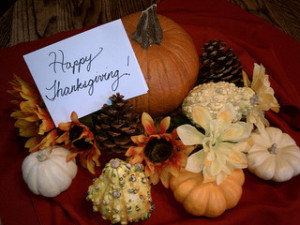It seems like food safety is in the news more and more. Last week, officials announced that an e. coli outbreak tentatively linked to a major chain restaurant has hit California (CBS News). Foodborne bacteria LOVE the holidays. As you contemplate Thursday’s feast, our San Francisco food safety law firm has some advice on holiday food safety to ensure foodborne illness doesn’t hit your Thanksgiving table.
Foodborne Illness and Holiday Celebrations
 Foodborne bacteria can strike at home as well as in commercial dining establishments. The Centers for Disease Control (“CDC”) webpage Tracking and Reporting Foodborne Disease Outbreaks reports that 48% of the outbreaks linked to a known single setting from 2009-2010 involved a restaurant or deli while 21% involved food consumed in a private home. We suspect these numbers might be skewed since it is easier to trace a larger outbreak to its source. Regardless, consumers have much greater control when it comes to home cooking.
Foodborne bacteria can strike at home as well as in commercial dining establishments. The Centers for Disease Control (“CDC”) webpage Tracking and Reporting Foodborne Disease Outbreaks reports that 48% of the outbreaks linked to a known single setting from 2009-2010 involved a restaurant or deli while 21% involved food consumed in a private home. We suspect these numbers might be skewed since it is easier to trace a larger outbreak to its source. Regardless, consumers have much greater control when it comes to home cooking.
Many people associate foodborne bacteria with hot summer months. However, the CDC’s “It’s Turkey Time” page notes that most outbreaks of clostridium perfringens, the second most common source of bacterial food poisoning, occur in November and December.
Turkey Safety
For most of us, centerpiece of the Thanksgiving meal is the turkey. Some tips from the CDC and Foodsafety.gov on turkey safety:
- Thawing/Storage – Purchase fresh turkeys no more than two days before preparation. Frozen turkeys are safe, but be sure not to leave them out for too long, including during your shopping trip (pick it up last, unpack it first!), and thaw safely. The danger zone is 40 to 140⁰F when bacteria present before freezing may start to grow. A sub-page contains some more detailed tips on thawing.
- Pre-Cooking Handling/Preparation – Do not wash the raw turkey; it spreads more bacteria than it eliminates! Use separate tools, including different cutting boards, for raw and cooked meats. Thoroughly clean hands, utensils, and work surfaces after working with raw poultry to avoid bacteria transfer.
- Cooking – Set the oven to a minimum of 325°F and begin cooking only after the turkey is fully thawed. The CDC recommend cooking breast-side up on a wire rack over a 2 to 2.5-inch-deep roasting pan. Cooking times vary. Test temperature using a food thermometer, ensuring it hits at least 165°F in the meaty part of the breast, thigh, and wing joint. Let stand for 20 minutes before removing stuffing (if relevant) and carving.
- Stuffing – The safest way to prepare stuffing is outside the turkey in its own dish. If you do stuff the turkey itself, do so immediately before cooking and use a food thermometer to make sure the center area reaches 165°F.
The Fixins’ and the Leftovers
Of course, turkey is only part of the story. Although all foods have their own safety issues, here are some general tips on holiday sides from Foodsafety.gov:
- Avoid Cross-Contamination — Keep side dish components separate and away from raw turkey. Good cleaning of utensils, hands, and surfaces is a must.
- Washing — Thoroughly wash all fruits and vegetables.
- Cooking – Cook items completely, including cooking dishes containing eggs to at least 160°F. Avoid partially cooking one day and finishing cooking another day, especially with multi-ingredient dishes like casseroles, because bacteria can multiply between cooking sessions even if the food is refrigerated. Resist the desire to taste foods before they are fully cooked (including that cookie dough!).
- Meat/Poultry/Seafood — Take extra care with anything containing meat, even just crumbled bacon in a vegetable side. Cook meat, poultry, and shellfish to safe temperatures before adding them to a recipe. Keep meat and/or cheese trays cold and make sure pre-assembled trays are refrigerated at the store.
- Leftovers — For many, this is the best part of Thanksgiving! Refrigerate leftovers as soon as possible and at least within two hours of cooking. Do not store stuffing in the turkey. Transfer leftovers out of cookware to help decrease temperature and limit the time food is in the unsafe 40°F to 140°F range. Be sure the fridge is set at 40°F or below and consume leftovers within 3 to 4 days. “Doggy bags” travelling more than two hours should be packed in a cooler with ice or frozen gel packs.
A Message from Our Team
At Thanksgiving and year-round, our San Francisco injury law firm gives thanks to everyone who helps make the Bay Area such a great place to live and work. We give special thanks to all of our clients for trusting us to help them in some of the most trying times of their lives. It is an honor to work with all of you.
We wish all of our readers a happy and safe Thanksgiving.
See Related Blog Posts:
Foodborne Illness Litigation: Examining the Law and Looking at a Shigella Outbreak in San Jose
Spotlight on Listeria as Retailers Pull Dips from Shelves Nationwide
(Image by Jennifer Gaillard)
 San Francisco Injury Lawyer Blog
San Francisco Injury Lawyer Blog

